




Your support is critical to our success.
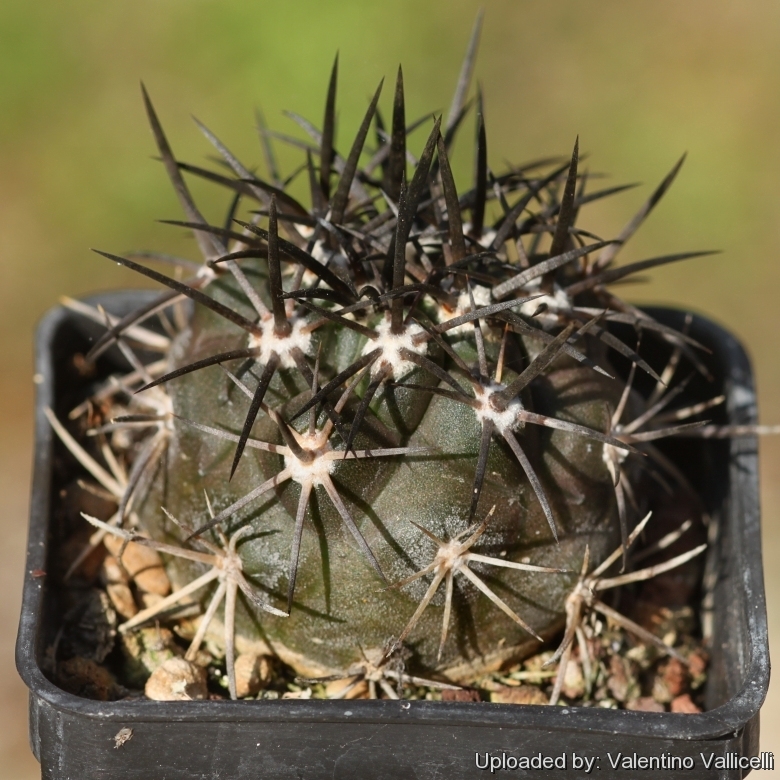
Origin and Habitat: West of Domeyko, about 30 Km from the coast, III region, Chile at about 86 km from the sea.
Altitude: 550-650 metres above sea level
Habitat: It grows on steep slopes on rocky soil along with scattered shrubs and other cacti such as Miqueliopuntia miqueliiSN|4177]]SN|4177]], and Eulychnia acidaSN|7067]]SN|7067]].
Synonyms:
- Copiapoa schulziana I.Schaub & Keim
Description: Copiapoa schulzianaSN|1564]]SN|9821]] is part of the very variable Copiapoa coquimbanaSN|1564]]SN|1348]] complex, but distinguishes for its tall and unbranched habit of growth, with stiff spines. Moreover its body is much large in size and epidermis is easily visible under the spines, even when the plants are retracted in time of drought. Plants are very characteristic and quite homogeneous in appearance, even the seedlings have a very uniform appearance and can easily be distinguished from seedlings of all other Copiapoas. Copiapoa schulzianaSN|9821]]SN|9821]] grows not far to the area of Copiapoa pseudocoquimbana var. domeykoensisSN|1348]]SN|1564]], but the two do not overlap and are noticeably different and distinct. Even the rare branched speciemens can be easily tell apart from Copiapoa pseudocoquimbana var. domeykoensisSN|9821]]SN|1564]] for their larger heads, visible stem surface and spination.
Root: Napiform often forked, yellowish-brown, neck slightly constricted. Lateral roots fibrous, growing mostly from the upper part of the central root.
Stem: Up to 50 cm tall and 23 cm in diameter, spherical or elongated with a slightly tapered apex, usually solitary or rarely forming multi-headed plants. Epidermis and ribs not obscured by spines, homogeneous pistachio green, without farinose coating, and crowned by a dense mass of white wool, particularly at flowering time. Apex up to 6 cm in diameter, spineless and depressed.
Ribs: There are 10 to 20 strongly tuberculate especially in young specimens
Tubercles: Rounded, slight depressed in correspondence to each areole.
Areoles: Large, broad, almost round about 8 mm in diameter, approximate, the adjoining ones usually touching. Young areoles filled with soft dull white felted wool quickly ageing to
almost dark grey and often sunken into the ribs.
Radial spines: 5-6 stout, fairly slender, straight and stiff, 10-30 mm long and o,6-0,8 mm in diameter, evenly spreading, erected with a narrow lateral spine angle, round in cross-section, dark chocolate-brown quickly ageing into pale grey.
Central spines: One, thicker, upward pointing, round in cross-section, 3,5-5 cm long and about 1,5 mm in diameter.
Flowers: 1 to 2 at a time, diurnal closing at night, fragrant, protracting the period of opening many days, funnel-shaped, 40-46 mm long and 30 mm in diameter growing from the centre of the grey wool at the apex. The perianth segments are 11-19 mm long and 5-7 mm wide, blunt and pale-yellow with a outer reddish mid-stripe. Pericarpel greyish, hairy. Style 18 mm long, yellow. Stigma yellow, 12 to 15 lobes, 3 mm to 6 mm long. Stamens 5 mm to 15 mm long, yellow.
Blooming season: Spring ( September onward in habitat)
Fruit: Round to elongate, with up to 180 seeds.
Seeds: 2 x 1,5 mm, black, shiny, surface with minuscule bumps.
Subspecies, varieties, forms and cultivars of plants belonging to the Copiapoa coquimbana group
 Copiapoa coquimbana (Karw. ex Rümpler) Britton & Rose: It branch profusely, forming large clumps up 1 m wide and 60 cm high. The spines are strong honey-amber, brown or black, and grey with age. Distribution: South of the Copiapoa genus range (from Coquimbo to La Serena)
Copiapoa coquimbana (Karw. ex Rümpler) Britton & Rose: It branch profusely, forming large clumps up 1 m wide and 60 cm high. The spines are strong honey-amber, brown or black, and grey with age. Distribution: South of the Copiapoa genus range (from Coquimbo to La Serena) Copiapoa coquimbana var. alticostata (F.Ritter) A.E.Hoffm.: has very strong, dark brown to black spines. Distributiom: between Freirina and Huasco.
Copiapoa coquimbana var. alticostata (F.Ritter) A.E.Hoffm.: has very strong, dark brown to black spines. Distributiom: between Freirina and Huasco. Copiapoa coquimbana subs. andina I.Schaub & Keim: has outstanding golden-yellow spines. This golden appearance is not typical of any other Copiapoa. Distribution: North east of Vallenar.
Copiapoa coquimbana subs. andina I.Schaub & Keim: has outstanding golden-yellow spines. This golden appearance is not typical of any other Copiapoa. Distribution: North east of Vallenar.- Copiapoa coquimbana var. armata F.Ritter
 Copiapoa coquimbana var. imbricata Kníže: has strong, chocolate-brown to almost black young spines. El Molle and adjacent areas, Rio Elavi.
Copiapoa coquimbana var. imbricata Kníže: has strong, chocolate-brown to almost black young spines. El Molle and adjacent areas, Rio Elavi. Copiapoa coquimbana var. pendulina (F.Ritter) A.E.Hoffm.: It is similar to C. pseudocoquimbana but with slightly stronger spines. Distribution: Coquimbo to Valparaiso.
Copiapoa coquimbana var. pendulina (F.Ritter) A.E.Hoffm.: It is similar to C. pseudocoquimbana but with slightly stronger spines. Distribution: Coquimbo to Valparaiso. Copiapoa coquimbana var. pseudocoquimbana (F.Ritter) A.E.Hoffm.: has longer and thinner spines, moreover radial spines are straight and not to curved toward the plant's body. Distribution: from the mouth of the Rio Choros to La Serena
Copiapoa coquimbana var. pseudocoquimbana (F.Ritter) A.E.Hoffm.: has longer and thinner spines, moreover radial spines are straight and not to curved toward the plant's body. Distribution: from the mouth of the Rio Choros to La Serena Copiapoa coquimbana vallenarensis (F.Ritter) A.E.Hoffm.: has few but steonger radial spines. Diatribution: Huasco and Vallenar Valley.
Copiapoa coquimbana vallenarensis (F.Ritter) A.E.Hoffm.: has few but steonger radial spines. Diatribution: Huasco and Vallenar Valley.- Copiapoa coquimbana var. wagenknechtii F.Ritter
 Copiapoa militaris Kníže: has stronger spines than the type. Distribution: Chanaralillo.
Copiapoa militaris Kníže: has stronger spines than the type. Distribution: Chanaralillo. Copiapoa pseudocoquimbana var. domeykoensis F.Ritter: is a giant form of C. coquimbana that is found on the far North part of the habitat of this species. Distribution: South-west of Domeyko.
Copiapoa pseudocoquimbana var. domeykoensis F.Ritter: is a giant form of C. coquimbana that is found on the far North part of the habitat of this species. Distribution: South-west of Domeyko. Copiapoa pseudocoquimbana f. variegata hort.: Variegated form. Garden origin (Nursery produced cultivar)
Copiapoa pseudocoquimbana f. variegata hort.: Variegated form. Garden origin (Nursery produced cultivar) Copiapoa pseudocoquimbana var. vulgata F.Ritter: has very long mostly stighter spines. Distribution: Coquimbo to Frai Jorge.
Copiapoa pseudocoquimbana var. vulgata F.Ritter: has very long mostly stighter spines. Distribution: Coquimbo to Frai Jorge. Copiapoa schulziana I.Schaub & Keim: mainly one-headed, non caespitose plants with much bigger head size, occasionally reaching heights of 50 cm as unbranched plants and up to 23 mm in diameter. Distribution: West of Domeyko, III region, Chile.
Copiapoa schulziana I.Schaub & Keim: mainly one-headed, non caespitose plants with much bigger head size, occasionally reaching heights of 50 cm as unbranched plants and up to 23 mm in diameter. Distribution: West of Domeyko, III region, Chile.
Bibliography: Major references and further lectures
1) Ingrid Schaub & Ricardo Keim “andina & schulziana due nuove copiapoa - two new copiapoas” TAXA – cactus cileni Chilean cacti, Cactus & Co. – Editoriale - Cacti Guide 05/Nov/2008.
2) Schulz R. & Kapitany A., (1996). “Copiapoa in their Environment” Schulz Publishing.
3) Schulz R., (2006). “Copiapoa 2006” Schulz Publishing.
4) Edward Anderson “The Cactus family” Timber Press, Incorporated, 2001
5) Friedrich Ritter - Kakteen in Südamerika (Ergebnisse meiner 20jährigen Feldforschungen) 1980
6) David R Hunt; Nigel P Taylor; Graham Charles; International Cactaceae Systematics Group. "The New Cactus Lexicon" dh books, 2006
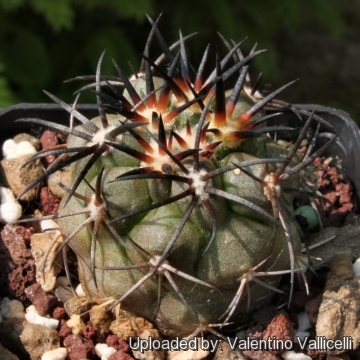
Copiapoa schulziana Photo by: Valentino Vallicelli
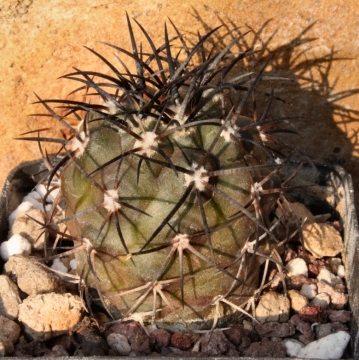
- KS442 west of Domeyco, Chile. Photo by: Valentino Vallicelli
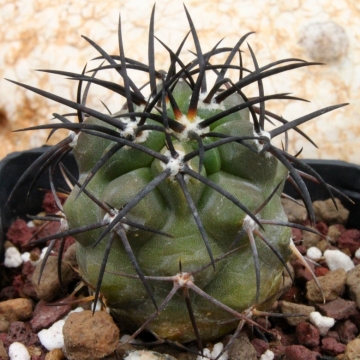
Copiapoa schulziana Photo by: Valentino Vallicelli
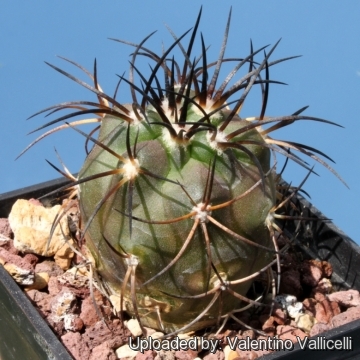
Copiapoa schulziana Photo by: Valentino Vallicelli
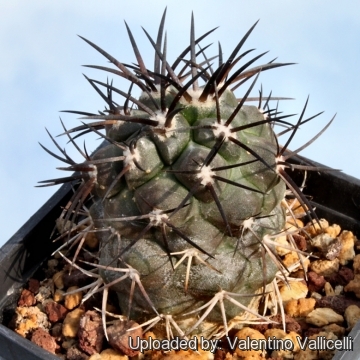
Copiapoa schulziana Photo by: Valentino Vallicelli
The gallery now contains thousands of pictures, however it is possible to do even more. We are, of course, seeking photos of species not yet shown in the gallery but not only that, we are also looking for better pictures than those already present. Read More...
Cultivation and Propagation: Considering that Copiapoa schulzianaSN|9821]]SN|9821]] comes from a habitat with an extremely arid climate, they are remarkably tolerant of pot culture. These plants have taproots and are susceptible to overwatering. They requires also an appropriate air circulation. Copiapoas are summer grower species easy to cultivate.
Growth rate: This is a slow growing cactus kept for the beauty of its form that will make clumps given the best conditions.
Soils: It likes very coarse mineral cactus mix soil, but can become too elongated if compost is too rich.
Repotting: Use pot with good drainage.
Watering: It requires light but regular waterings in summer, but let the soil mix dry between waterings, but do not overwater (Rot prone), it must be strictly kept dry throughout the winter quiescent period since it is very sensitive to any moisture excesses keep dry in winter.
Fertilization: Feed with a high potassium fertilizer in summer.
Hardiness: Not highly tolerant of a great deal of frost. They need to be kept in a cool place during winter rest and are resistant to light frost if kept on the dry side prior to, and during, cold weather ( they are hardy to -2 C ° C short periods). However some warmth throughout the year will increase the grower's success (minimum 5° to 10°C during rest season).
Exposition: Requires full sun or light shade and careful watering to keep plant compact with strong coloured spines. Tends to bronze in strong light, which encourages flowering and heavy spine production. Light shadow my be useful in the hottest summer days.
Uses: It is an excellent plant for container growing. It always looks good and stays small. It look fine in a cold greenhouse and frame or outdoor in a rockery.
Pests & diseases: It may be attractive to a variety of insects, but plants in good condition should be nearly pest-free, particularly if they are grown in a mineral potting-mix, with good exposure and ventilation. Nonetheless, there are several pests to watch for:
- Red spiders: Red spiders may be effectively rubbed up by watering the infested plants from above.
- Mealy bugs: Mealy bugs occasionally develop aerial into the new growth among the wool with disfiguring results, but the worst types develop underground on the roots and are invisible except by their effects.
- Scales: Scales are rarely a problem. It is wise to treat your whole collection with a systemic insecticide twice a year in spring and autumn.
- Rot: Rot is only a minor problem with cacti if the plants are watered and “aired” correctly. If they are not, fungicides won't help all that much. To prevent rottenness it is also advisable to surround its root neck by very rough sand or grit, this help a fast water drainage.
Propagation: Seeds (or offsets if available), Grafting is often used to speed growth rate and to create a back-up to plants in collection. Seeds germinate in 7-14 days at 21-27° C in spring, remove gradually the glass cover as soon the plants will be well rooted (ca 1-2 weeks) and keep ventilated, no full sun for young plants!
| Your Actions | |
|---|---|
| Back to Copiapoa index | |
| Back to Cactaceae index | |
 |
Back to Cacti Encyclopedia index |
Privacy stantement - Terms and conditions - How to cite - About us - Feedback - Donate



